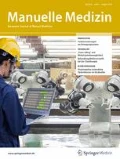Zusammenfassung
Bei korrekt manualtherapeutisch behandelten, aber immer wieder rezidivierenden funktionellen Wirbelsäulenstörungen und Beschwerden sollte an die kraniomandibuläre Region gedacht werden, die neuromuskulär gesteuert in direkter Wechselwirkung zur kraniozervikalen Region steht. Dies gilt auch dann, wenn keine offensichtlichen Symptome einer kraniomandibulären Dysfunktion (CMD) beklagt werden, d. h. eine stumme CMD vorliegt. Vielen bislang therapieresistenten Patienten kann durch eine abgestimmte, synchrone Behandlung der CMD und der funktionellen Halswirbelsäulenstörungen geholfen werden. Besonders beachtet werden muss auch eine stumme CMD. Diese wird wegen der fehlenden Schmerzsymptomatik sehr häufig übersehen. Anhand der vorgestellten Kasuistik mit der Diagnose „Fibromyalgiesyndrom“ wird diese Problematik diskutiert.
Abstract
In patients who have been correctly treated by manual therapy but with continually recurring functional disorders and complaints of the spine, the craniomandibular region should be taken into consideration as it lies in direct neuromuscularly controlled interaction with the craniocervical region. This is also the case when there are no complaints of obvious symptoms of craniomandibular dysfunction (CMD) and an asymptomatic CMD is present. Many previously therapy-resistant patients can be helped by a coordinated synchronous treatment of CMD and functional disorders of the cervical spine. Special attention must also be paid to asymptomatic CMD, which is often overlooked due to the lack of symptoms. This problem area is discussed using a patient case report with the diagnosis of fibromyalgia syndrome as an example.




Literatur
Cooper BC, Kleinberg I (2008) Establishment of a temporomandibular physiological state with neu-romuscular orthosis treatment affects reduction of TMD symptoms in 313 patients. Cranio 25:104–115
Eich W, Hauser W, Arnold B, Jackel W, Offenbacher M, Petzke F, Schiltenwolf M, Settan M, Sommer C, Tolle T, Uceyler N, Henningsen P, Arbeitsgemeinschaft der Wissenschaftlichen Medizinischen (2012) Fibromyalgia syndrome. Definition, classification, clinical diagnosis and prognosis. Schmerz 26(3):247–258
Frisch H (2001) Programmierte Untersuchung des Bewegungsapparates. Chirodiagnostik. 9. Aufl. Springer, Berlin
Hülse M, Losert-Bruggner B, Schöttl R (2003) CMD, CCD und neuromuskulär ausgerichtete Bisslagebestimmung. Dent Prax XX 7/8:195–208
Hülse M, Losert-Bruggner B (2008) Die kraniomandibuläre Dysfunktion. Ein Folgezustand nach erlittenem HWS-Trauma. HNO 56:1114–1121
Jankelson R (1990) Neuromuscular dental diagnosis and treatment. Ishiyaku Euro-America, St. Louis, Tokyo
Losert-Bruggner B, Dudek B, Hülse M (2010) Die kraniomandibuläre Dysfunktion (CMD). Eine mögliche Ursache für chronische Schmerzen und nicht erholsamen Schlaf. Man Med 48:343–352
Plato G, Kopp S (1999) Kiefergelenk und Schmerzsyndrome. Man Med 37:143–151
Hülse M, Neuhuber W, Wolff HD (Hrsg) (2005) Die obere Halswirbelsäule. Springer, Berlin Heidelberg
Schupp W (2005) Kraniomandibuläre Dysfunktionen und deren periphere Folgen. Eine Lite-raturübersicht. Man Med 43:29–33
Zafar H (2000) Integrated jaw and neck function in man. Studies of mandibular and head-neck movements during jaw opening-closing tasks. Swed Dent J Suppl 143:1–41
Author information
Authors and Affiliations
Corresponding author
Ethics declarations
Interessenkonflikt
B. Losert-Bruggner, M. Hülse und R. Hülse geben an, dass kein Interessenkonflikt besteht.
Alle beschriebenen Untersuchungen am Menschen wurden im Einklang mit nationalem Recht sowie gemäß der Deklaration von Helsinki von 1975 (in der aktuellen, überarbeiteten Fassung) durchgeführt.
Rights and permissions
About this article
Cite this article
Losert-Bruggner, B., Hülse, M. & Hülse, R. Fibromyalgie oder funktionelle Kopf- und Kiefergelenkstörung?. Manuelle Medizin 55, 94–99 (2017). https://doi.org/10.1007/s00337-017-0245-9
Published:
Issue Date:
DOI: https://doi.org/10.1007/s00337-017-0245-9

